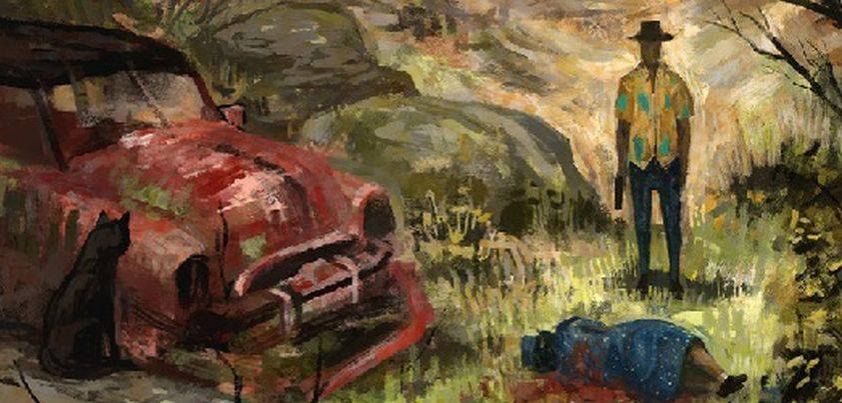In A Good Man is Hard to Find, the story begins with the characters planning a family trip to Florida. However, the unnamed Grandmother, the matriarch, disagrees with the rest of the family as she would instead go to Tennessee. The Grandmother mentions a dangerous individual, the Misfit, to make her case against going to Florida.
The Grandmother shows her son Bailey, whose family she lives with, a newspaper that reports about the Misfit. The Misfit is a dangerous criminal who escapes a federal prison and is believed to be heading to Florida. The selfish Grandmother, whose real intention is to visit her connections in Tennessee, fails to convince the family to change their mind. Along the way, she convinces the family to take a detour for sightseeing. This adventure ends in tragedy as the car crashes into a ditch, where the Misfit catches up with them and kills the whole family.
Point of View
The events in A Good Man is Hard to Find are narrated from a third-person narrator’s point of view (limited omniscient). Reading through the story depicts the narrator as objective because they cover the events faithfully. However, the narration is biased and limited because it is only the Grandmother’s feelings and thoughts that the narrator accesses, not those of the other family members. Even after the Misfit murders the grandmother, only a dialogue between him and his accomplices is provided, and the narrator fails to provide insight into his feelings and thoughts. We can only learn about the characters through the Grandmother’s perspective.
Setting
The story’s setting is post-war midcentury in Georgia. The family begins the journey from the suburbs of Atlanta and travels to the town of Toombsboro in a few hours, where the Grandmother convinces them to take a detour onto a dirt road. The story’s setting features characteristic local flavors like Red Sammy’s barbeque, old plantations, and other sights. The second setting critical to the story is the ditch between the road and a tall, dark forest where the rest of the family is murdered. As for time, the family leaves home in the morning and reaches Red Sammy’s in the ‘hot afternoon’ probably in summer. The narrator does not specify the era, but one may estimate it is in the 1940s or a little later. The Grandmother states “the way Europe acted you would think we were made of money” (44), showing that it is after the Second World War. Furthermore, the book was written in 1953, hence the events can be placed in the late 1940s or early 50s.
Theme
The central theme in the story is finding grace since the unfortunate events allow the once selfish Grandmother to find and understand grace. In the beginning, the Grandmother finds herself as the most morally and socially superior individual. She is judgmental and scornfully looks at people who do not measure up to her standards. Although she dresses like a proper lady and takes excellent care of herself, her heart carries ugly tendencies like prejudice, deception, and selfishness. However, her encounter with the Misfit strips her of her superiority, and realizes how much she is flawed. The Grandmother sees her connectedness with the Misfit as her son, representing her only moment of compassion throughout the story and the ultimate point of grace.
Characters
The grandmother is the protagonist and the central character of the story. She is a selfish, manipulative, and condescending woman. She is the character whose head the reader gets inside and whose reaction the audience hears. Her character as a conniving and patronizing manipulator is revealed when she faces the evil inform of the Misfit. The antagonist is the Misfit, who fails to abide by any religious or cultural morals and does as he pleases. The Misfit is depicted as a complicated and callous person who murders an entire family without remorse. The minor characters include Bailey, who is the head of the family. Bailey loves his mother but disapproves of her selfish and judgmental behavior. John Wesley is Bailey’s eight-year-old son, who is obnoxious and loud. John Wesley wants to visit the house the Grandmother talks about because it has a secret panel. June Star is Bailey’s young, obnoxious, and observant daughter known for speaking her mind aloud. The mother is Bailey’s wife and mother to the baby, June, and Wesley, who breaks her shoulder in the accident. Red Sammy, as described by the Grandmother, is a gullible, trusting, and good man who owns the Tower restaurant. The last minor characters are Hiram and Bobby Lee, the escaped criminals, and the Misfit’s henchmen.
Conflict and Climax
The central conflict in the story is the external conflict between society and the Grandmother. The Grandmother judges society harshly and carries a sense of superiority over the people around her. The Grandmother is depicted as a self-righteous and domineering person with whom the family finds it hard to get along. The author develops this conflict and the Grandmother’s character to ultimately result in the story’s climax. Therefore the climax of the story is the moment the grandmother experiences grace during the encounter with the Misfit. Thus, the story’s thematic climax involves the offer and acceptance of grace following the epiphany the Grandmother experiences just before she is shot.
Situational Irony
Situational irony happens when an event in a story is the opposite of what the readers expect. In O’Connor’s story, the situational irony is when the Misfit, a man heartless and dangerous criminal with no morals, contributes to the Grandmother’s graceful moment and helps her see herself for who she truly is. An evil man facilitates a sinner’s enlightenment allowing her to cast off her selfishness and redeem herself. Even as the Misfit shoots her, instead of being afraid, the grandmother dies with a smile.
Resolution
The story’s resolution is depicted after the Misfit shoots and kills the Grandmother and after he and the two criminals dispose of the body. The Misfit states that the Grandmother, “would have been a good woman if it had been somebody there to shoot her every minute of her life”(O’Conner). Moreover, during this point, the Misfit contradicts himself about killing when he states, “is no pleasure in life” (O’Conner). Here, the author shows the transformation of the Grandmother and the Misfit after their conversation. While the Grandmother finds grace and redemption, the Misfit realizes that killing is no fun as he initially thought.
Work Cited
O’Connor, Flannery. A good man is hard to find. New English Library, 1962.


